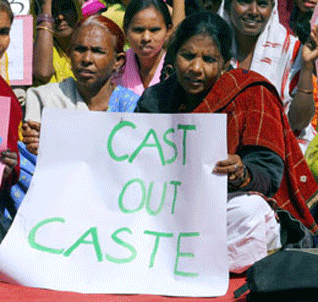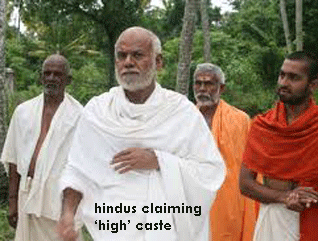Kids' Corner
The Caste System
Living Sikhi, Lesson Eighteen
by VERONICA SIDHU
THE CASTE SYSTEM
Lesson Objectives:
1 To answer the question: What is the caste system?
2 To learn what were the ancient benefits and what is now the harm to society.
3 To learn the names of the four castes and the outcastes.
Teachers, ask the students to say the Sikh greeting with you; then fold hands and do simran with the students.
Homework review: Ask the students if they sat or played with a student who seemed to have few friends in school. Then ask to share what they felt when they ate or played with that student.
Teachers: Please do not judge the answers. The students may begin a lively discussion or you may use the following questions as prompts: Were you happy to be doing something nice? Were you scared of what others would say? Were you ashamed to be with the student? Were you surprised by something the student said or did? How did others react?
What you may have experienced when interacting with the child with few friends may have been a little like what Guru Nanak found when he ate with Bhai Lalo. Sometimes there are social structures in the classroom and on the playground that no one really talks about, but most kids know. Who is most popular, who gets the best grades, who has the most expensive clothes, who is the strongest - sometimes these kids will get to tell other people what to do, or other people let them do what they want. These kids are like kids in the upper castes in that way, and the child with few friends may be like someone in the lower caste, but not in the total way that you would be if you were born into a society that practiced the Hindu Caste System of India.
The social structure called the Caste System is different in that it is taught openly in Hinduism and it governs everything in a person's life. In Guru Nanak's time and in many places in India today, a child of low caste would not be able to enter a classroom. Think about it this way: if you break your arm, the doctor may put it in a very stiff covering that does not move. It also is called a cast. If for example, you were born into a family of goldsmiths in Guru Nanak's time, you would have to learn how to make jewelry, even if you had a brilliant mind that would like to learn the scriptures and read the holy books. This is what the caste system is like. It keeps people in whatever place they were born into and governs much of what they can or cannot do - what and with whom they eat, to what they learn, where they live, where and how they worship God, what they do for a living, and whom they marry. This is changing in some places among Indians today but not everywhere, and shockingly, some people who call themselves Sikhs continue some of these practices - even though it is a Hindu system and is strictly prohibited in Sikhism..
The Caste System was brought by the Aryans to India many thousand years ago and later became a central part of the Hindu religion. People were told that they were born into a certain place in society because of their past deeds or actions in other lifetimes. No one or nothing could change their position upwards, only downwards. So shame and fear kept the classes and outcastes in their place.
In the ancient days, this made some sense when there were few schools or universities because parents were required to teach their children their profession or job. So, if the parent was a farmer, the child worked with his father in the fields and learned how to farm. If the father was a dancer, the child learned dancing. If the father was a priest, the child learned to recite the holy books from memory and later to read and write. Also, elaborate rules of cleanliness prevailed before there was soap and water.
Otherwise, few others learned to read and write. Only males were generally taught a profession; girls were married off to boys of the same caste and stayed at home.
There were benefits in having a caste system, but they were only enjoyed by those in the 'upper' castes. You could tell the lower castes what to do and they had to listen. You had more power to do what you wanted to do. People did not ask you any questions. Many in the upper castes reasoned that they didn't have to help anyone, because, if people needed their help, it was because they had done something bad in their past life to deserve it. It seemed very good for the few people on the top of the caste system ladder and very bad for the majority of people at the bottom.
There were four castes:
The Brahmins - priests and teachers
The Kshatriyas - rulers and warriors
The Vaisyas - artisans and merchants (business)
The Shudras - commoners, people like farmers who worked with their hands
The fifth group consisted of the outcastes or pariahs. These people did work like sweeping, cleaning toilets, skinning animals, etc.
Each of these groups was further divided into hundreds of smaller sub-groups.
So, if you lived in Guru Nanak's time and you were born to a carpenter, you would have to learn to be one, even if you couldn't hammer a nail straight or only had one arm. Do you see why, in the modern world, the Caste System is very detrimental to follow? It disregards the abilities and talents God has given individuals so that, no matter what, just a few people who are at the top can keep their children and grandchildren forever at the top. It forces people to stay on a path that society has given to them. It disrespects the talents God has given to each person individually and does not allow those people to follow the path God has made just for them. And worst of all, it becomes an excuse to treat people unfairly. Practicing the caste system prevents the 'upper' classes from reaching God because they become proud and cruel. It prevents the 'lower' classes from reaching God because they feel miserable and unworthy.
What do you think Guru Nanak would say about people who still practice the caste system today? (Pause for answers)
Homework: There are some social structures and institutions today that try to preserve power and/or money for themselves and their children to the detriment of others.
Define feudalism, slavery, royalty, dynasty, religious hierarchy and priesthood. Give one example of how each is continuing today in some parts of the world, despite the message of Guru Nanak that all men and women are as brothers and sisters, that they are equal under One God.
Shabad: Sa rasna dhan dhan hai
Alternate Shabad: Lakh Khushiaan Patshaa-i-aan
August 16, 2010
Conversation about this article
1: Jagdeep Singh (London, England), August 22, 2010, 7:31 AM.
Sikhs must rid themselves of the residual caste practices they have inherited from the Hindus.





